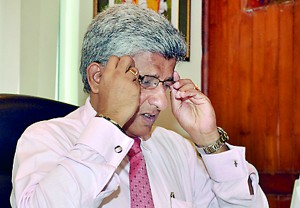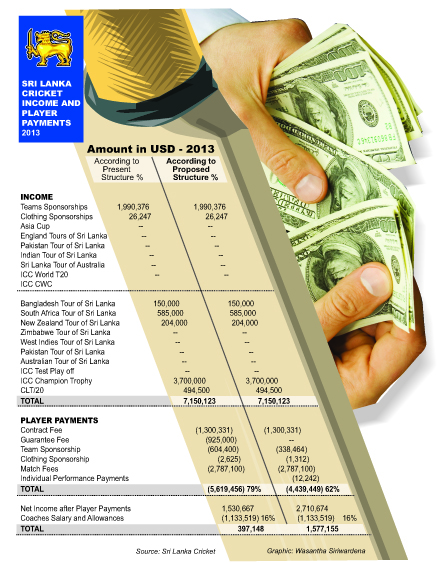SLC justifies pay-cut for players
View(s):Nishantha explains reasons behind multi-million-rupee crisis
By S.R. Pathiravithana
Sri Lanka Cricket Secretary Nishantha Ranatunga claims that there should be wisdom when handling SLC’s finances and it was time to take a deeper look at matters at hand and take, may be, some unpopular decisions to keep the game within a workable frame.
He is of the view that as a small nation, Sri Lanka is in no position to sustain its game by distributing 79% of its gross income among 23 cricketers.
He began his defence saying, “A clear disparity exists between Sri Lanka and other Test playing countries. TV viewership in a country is a huge yardstick in this matter. For instance, just look at the populations of our cricket playing neighbours – India, Pakistan and Bangladesh in comparison to the twenty million viewers in Sri Lanka; their populations are simply huge. So when a TV company churns out a deal this data take the pride of place. This is one scenario. The other is, take the affluent cricket playing nations like Australia, England and South Africa. Their per capita income is much bigger than Sri Lanka. The other drawback is a cultural one. For instance in most of those countries the main sponsors of the game are companies who are engaged in either alcohol or the tobacco industry. In Sri Lanka those two components are not encouraged to take part in sports related activities.
“So when one takes these factors into consideration you cannot make an income frame to Sri Lankan players akin to those of the other Test playing nations. The formula should be one of our own. It should be a formula that fits our income and the formula should also cover the other aspects of the game. I am quite aware that our players are in a lower capacity in comparison to the players of some of the other countries, but this parameter does not confine only to the cricketers of this country, but this a dilemma is faced by all walks of professionals in this country.” Ranatunga pointed out when you have to spend 80% of the national cricket income among 23 players it becomes an unrealistic task to sustain the rest of the work. The monies that have been kept aside with the new deal for the  development work would go into several areas of the game. For instance he pointed out that invariably it is the schools structure of this country that acts as the main feeder point to our game. Then the SLC will have to help the schools sustain the game in their own institutions. It comes by the way of maintaining grounds, buying cricket equipment, paying coaches and other allied expenses. It is the same with the clubs. The same criteria apply even to club cricket.”
development work would go into several areas of the game. For instance he pointed out that invariably it is the schools structure of this country that acts as the main feeder point to our game. Then the SLC will have to help the schools sustain the game in their own institutions. It comes by the way of maintaining grounds, buying cricket equipment, paying coaches and other allied expenses. It is the same with the clubs. The same criteria apply even to club cricket.”
Ranatunga said it is imperative that the clubs which do have the infrastructure should be helped to sustain them. He said the board has only a limited number of grounds. All cricket grounds have to be looked after at the same intensity. Another section of cricket that should be looked through in earnest is the outstation cricket, especially the areas where the SLC could not take the game in the past thirty years.
“There is enough talent coming from the outstation. Now with the cricketers coming in from the North and the East it becomes a plus point. Then if we are to reap the real benefits of this situation there is expenditure involved. For that we must make sure that we do our work in the districts and the provinces,” he said.
Besides, Ranatunga said that there are other areas that incur expenses. “Expenses for security, anti-doping, anti-corruption – all these involve substantial amounts of monies though it is not seen by the majority of the people. Then the expenses for the match officials, sustenance of the SLC facilities and keeping them to the ICC requirements, then the women’s cricket, we have to make provisions for all this with the income we get. So I think the cricketers as well as the public should understand that this is not about the income of 23 players, but a challenge that runs deep into the roots of Lankan cricket.”
Commenting on the income of Sri Lanka Cricket, Ranatunga said one cannot take this segment in yearly chunks. He said the SLC’s income varies from year to year. For instance, he said that when a country like Australia or India plays in Sri Lanka there is an additional revenue. Then as a module one will have to take the income in four year brackets to feel what our average income would be. Generally, to sustain cricket in Sri Lanka, the SLC needs around US$ 8-10 million a year.
We asked him about the problem at hand — the players’ fees. This income that they have been enjoying was provided by the administration at one point of time. Then why cut it? Ranatunga explained, “How I see this is with all due respect to the previous officials, I think they had not made an exact module of Sri Lanka’s cricket income and at times arrived at haphazard decisions. Yes, the cricketers have fought and got some payments and at times they have performed and got some of these privileges. But when they were given those perks and privileges, the administrators should have looked into how they were going to sustain them.”
Then Ranatunga spoke about the thorn-in-the-flesh — the ICC 25% Guarantee fee. He said, “We wrote to the other administrations around the globe and found out if they are making this allocation to the players. Most of them said that they do not pay it. Cricket Australia said they share 26% among all cricket playing segments in the entire country. I think it is a miscommunication to say that the other countries pay this. We have documentary evidence to prove that fact.”
He also added: “The 23 players in question are well looked after by the SLC. They get their coaching staff, physios, masseurs, playing kits including helmets and even the bags to carry their equipment are provided by the board. As a matter of fact, besides the players, another 40% of salary allocations of the SLC go towards the coaching staff.”
The SLC secretary also pointed out that among the majority of the cricketers who are competing for places in the national team do not get a monthly income of even Rs.50,000, but some of these star class players rake in an income of about Rs. 5 million a month. “If that is not good enough for them there is a question mark – the amount I specified does not include their income from the IPL, BPL, SLPL, the Big bash and other advertising incomes.” he said in conclusion.
Follow @timesonlinelk
comments powered by Disqus


















